VAST Quick-start Guide
A Video Ad Serving Template (VAST) ad item is meant to be played or displayed within or around a media player, such as the ads in YouTube videos and podcasts. Aside from supporting various media files, the VAST specification allows AdButler to track various indicators of user behavior, such as how long someone watched an ad or if they muted it.
A VAST ad item can have one or more VAST creatives, and a VAST creative itself can be one ad or a group of ads. In particular, a VAST creative can have only one linear media ad, but it can also have one or more non-linear media ads and companion ads. Each of these ads can have their own click and event trackers.
For VAST 4.2 ad items, the IAB highly recommends linear media ads to have three quality versions of the same file - low, medium, and high quality - to ensure that the ad will be served even in low bandwidth environments. In addition, if your ad will be sent through an ad-stitching server, the IAB also recommends that you include a mezzanine file, which is the raw video or audio file. For more information, read VAST file recommendations.
- How to create a VAST campaign.
- How to create a VAST 2.0 ad item.
- How to create a VAST 4.0 ad item.
- How to create a VAST zone.
- How to assign a VAST campaign to a VAST zone.
- How to test a VAST zone tag.
Creating a VAST campaign
- Go to the section of the relevant advertiser (Your AdButler > Advertisers > Your Advertiser).
- Click Add Campaign above the table of campaigns. The Create Campaign window will appear.
- Click VAST campaign.
- Name the campaign.
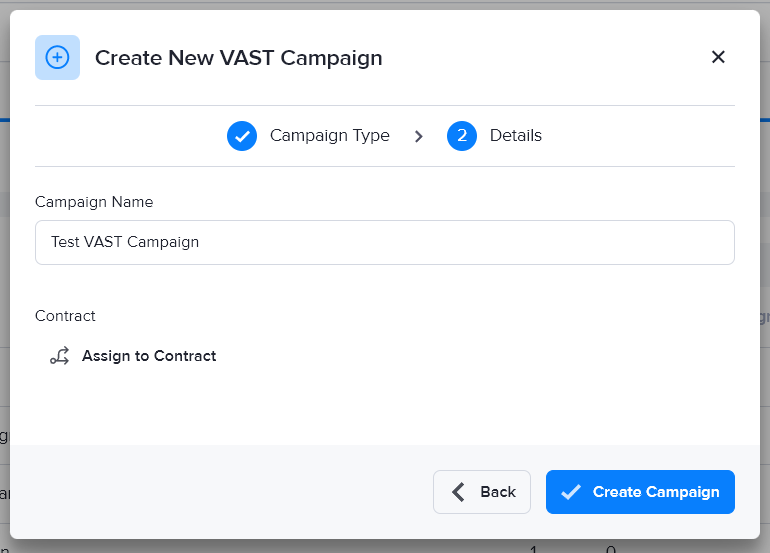
- Assign the campaign to a contract. (optional)
- Click Create Campaign.
You can now create VAST 2.0 and VAST 4.2 ad items in this campaign. For more information on campaigns, read About campaigns.
Creating a VAST 2.0 ad item
- Go to the section of the relevant VAST campaign (Advertisers > Your Advertiser > Your Campaign).
Click on Add New v2.0 above the VAST Ad Items table. The New VAST Ad window will appear. From here, you can:
Add a VAST wrapper
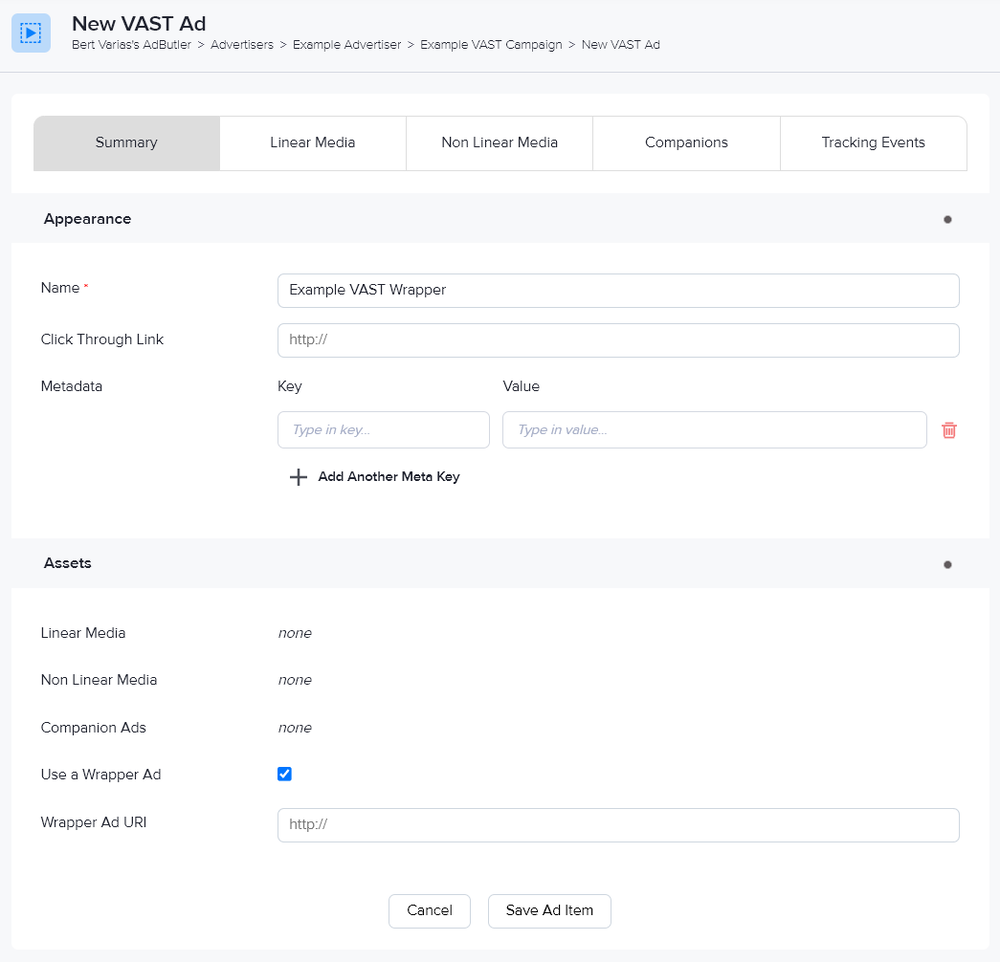
- In the Summary tab, give the VAST ad item a name. The click through link is optional. If you enter a URL, you can test it by clicking Open Destination URL to the right of the field.
- Add one or more metadata tags to the ad item. (optional)
- Under Assets, check Use a Wrapper Ad.
- Paste the wrapper ad URI from the third-party server.
- Click Save Ad Item.
Add a linear ad
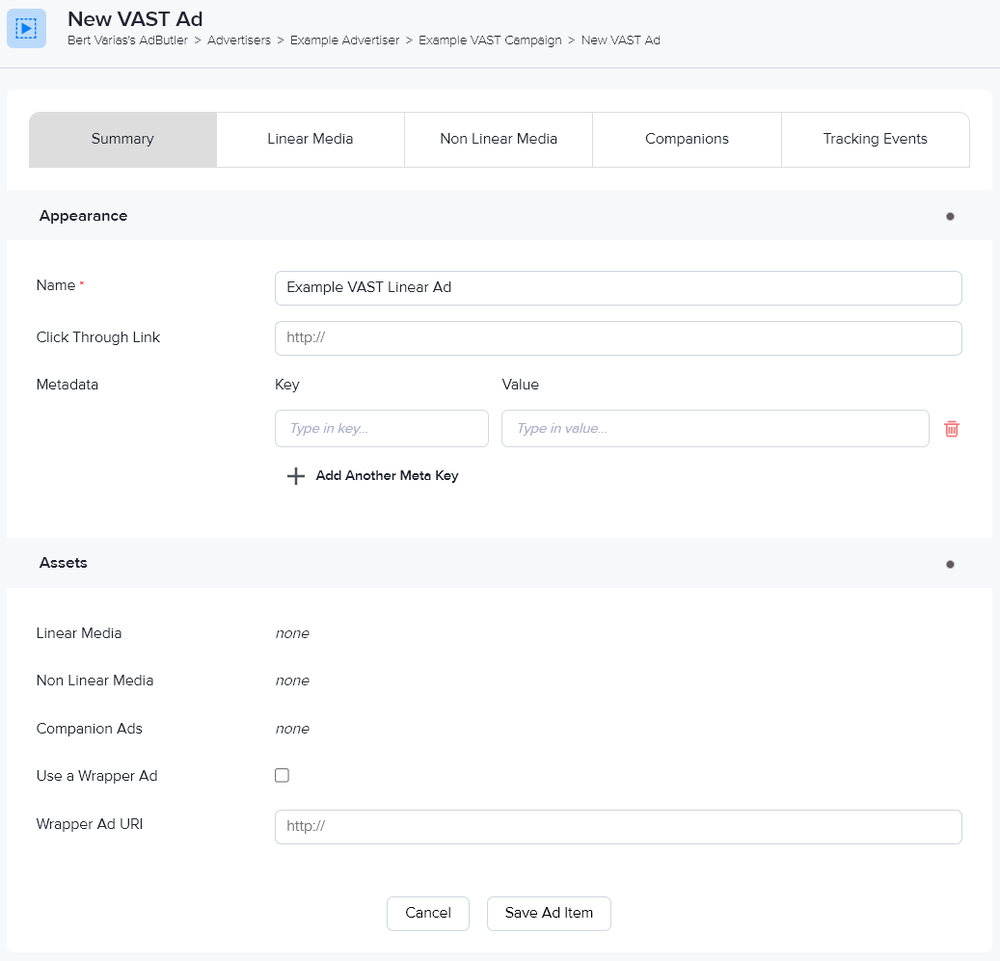
In the Summary tab, give the VAST ad item a name and add a click through link. You can test the URL by clicking Open Destination URL to the right of the field.
Add one or more metadata tags to the ad item. (optional)
Click on the Linear Media tab.
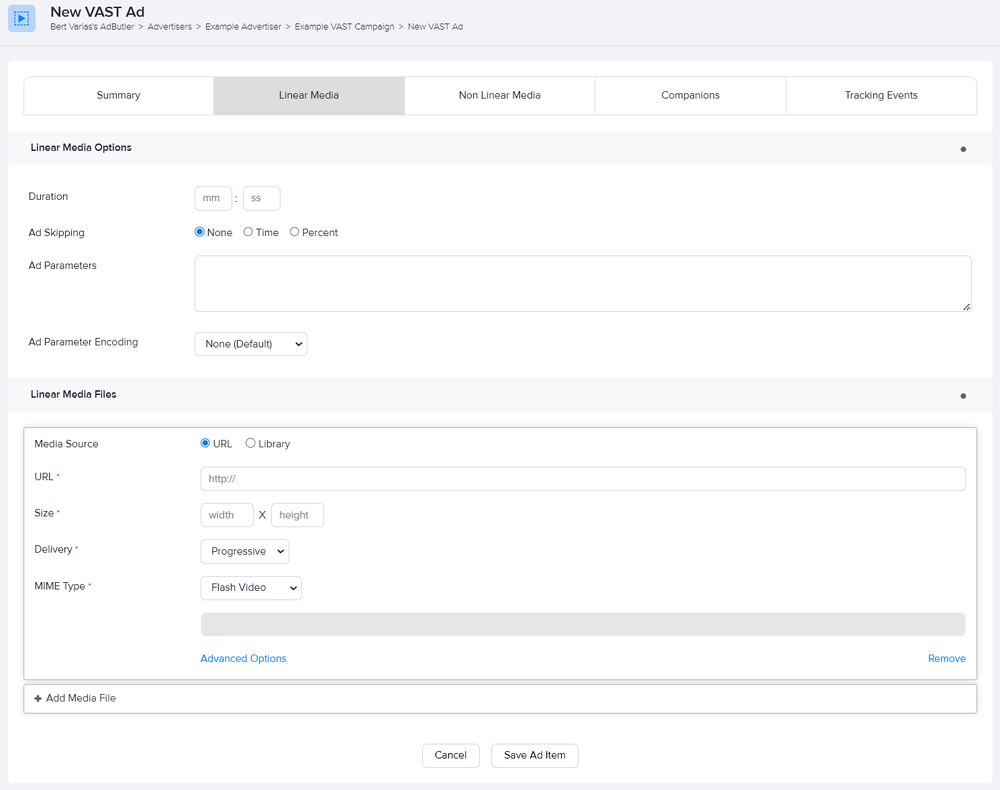
- Under Linear Media Files, enter the URL of the online media source, select a file in the Media Library, or upload a file from your computer.
Click Advanced Options if you need to specify other settings, such as enabling scalability, maintaining the aspect ratio, or adding the parameters for executable media files or interactive files.
Click on the Tracking Events tab then select one or more events to track alongside their parameters. You can send the same event to multiple URLs, but you have to make a separate entry for each URL. (optional)
Click Save Ad Item once you've finished configuring all the components of the ad item.
Add a non-linear ad
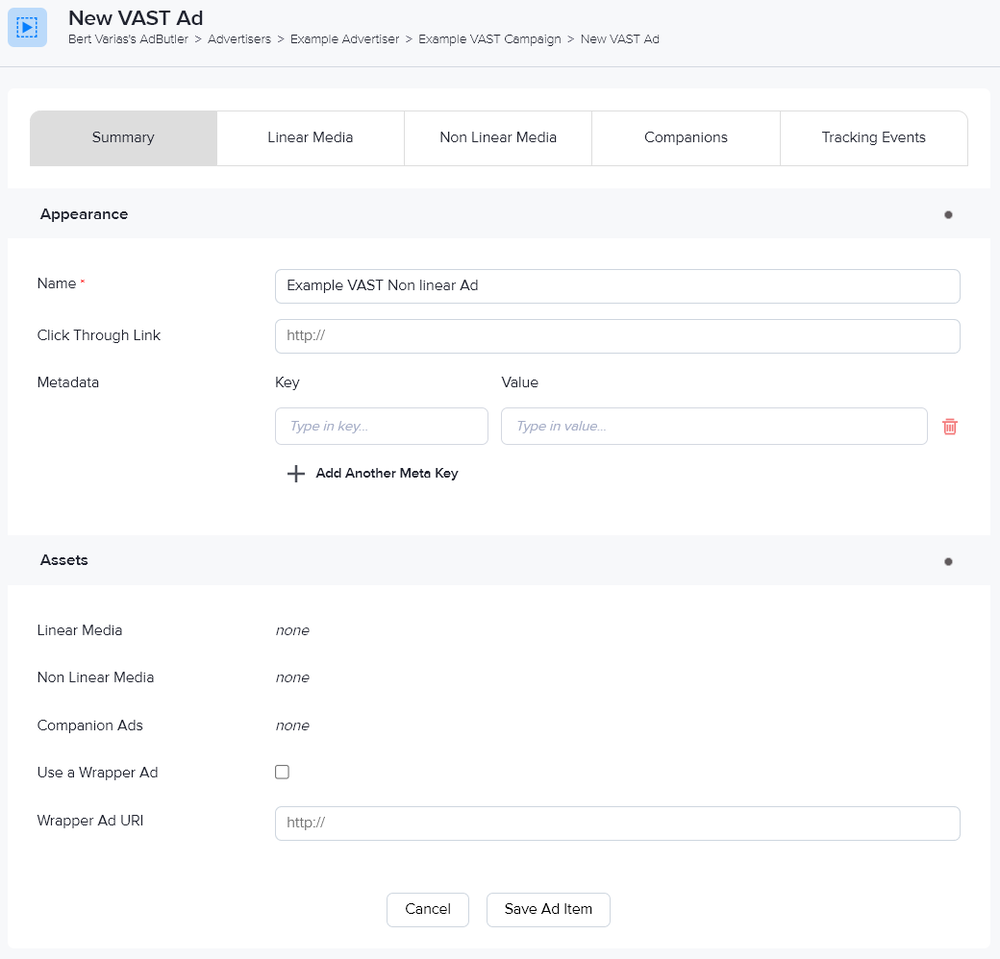
In the Summary tab, give the VAST ad item a name and add a click through link. You can test the URL by clicking Open Destination URL to the right of the field.
Add one or more metadata tags to the ad item. (optional)
Click on the Non Linear Media tab.
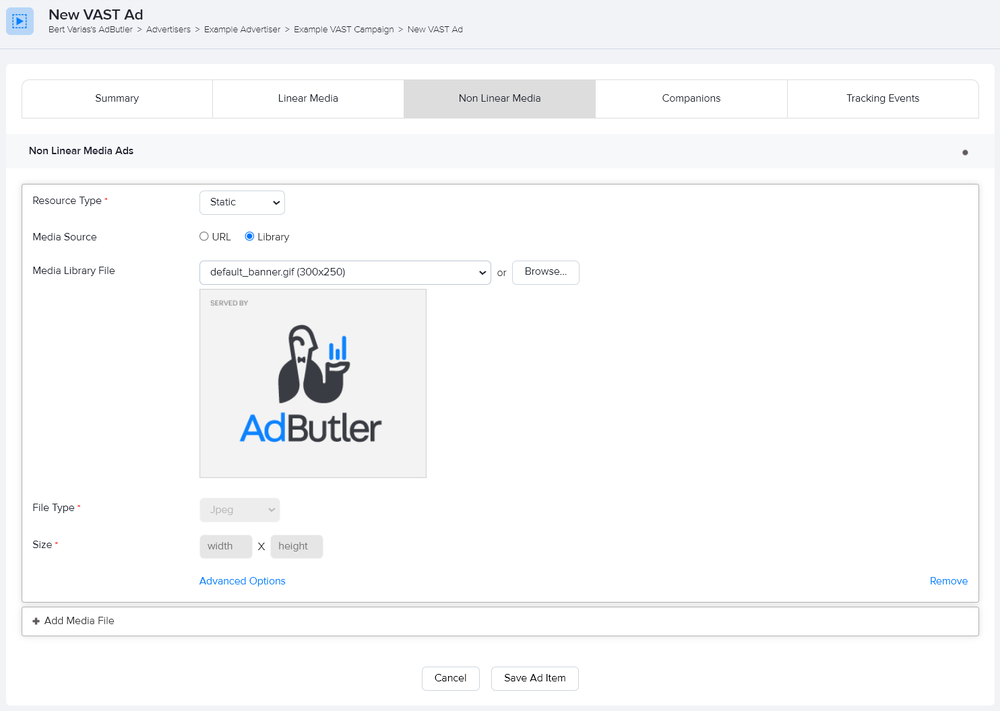
- Under Non Linear Media Ads, enter the URL of the online media source, select a file in the Media Library, or upload a file from your computer.
If the image is from an online source, select its file type and enter its dimensions in the appropriate fields.
Click Advanced Options if you need to specify other settings, such as the bitrate, the codec, or the required API for interactive files.
Click on the Tracking Events tab then select one or more events to track alongside their parameters. You can send the same event to multiple URLs, but you have to make a separate entry for each URL. (optional)
Click Save Ad Item once you've finished configuring all the components of the ad item.
Add a companion ad
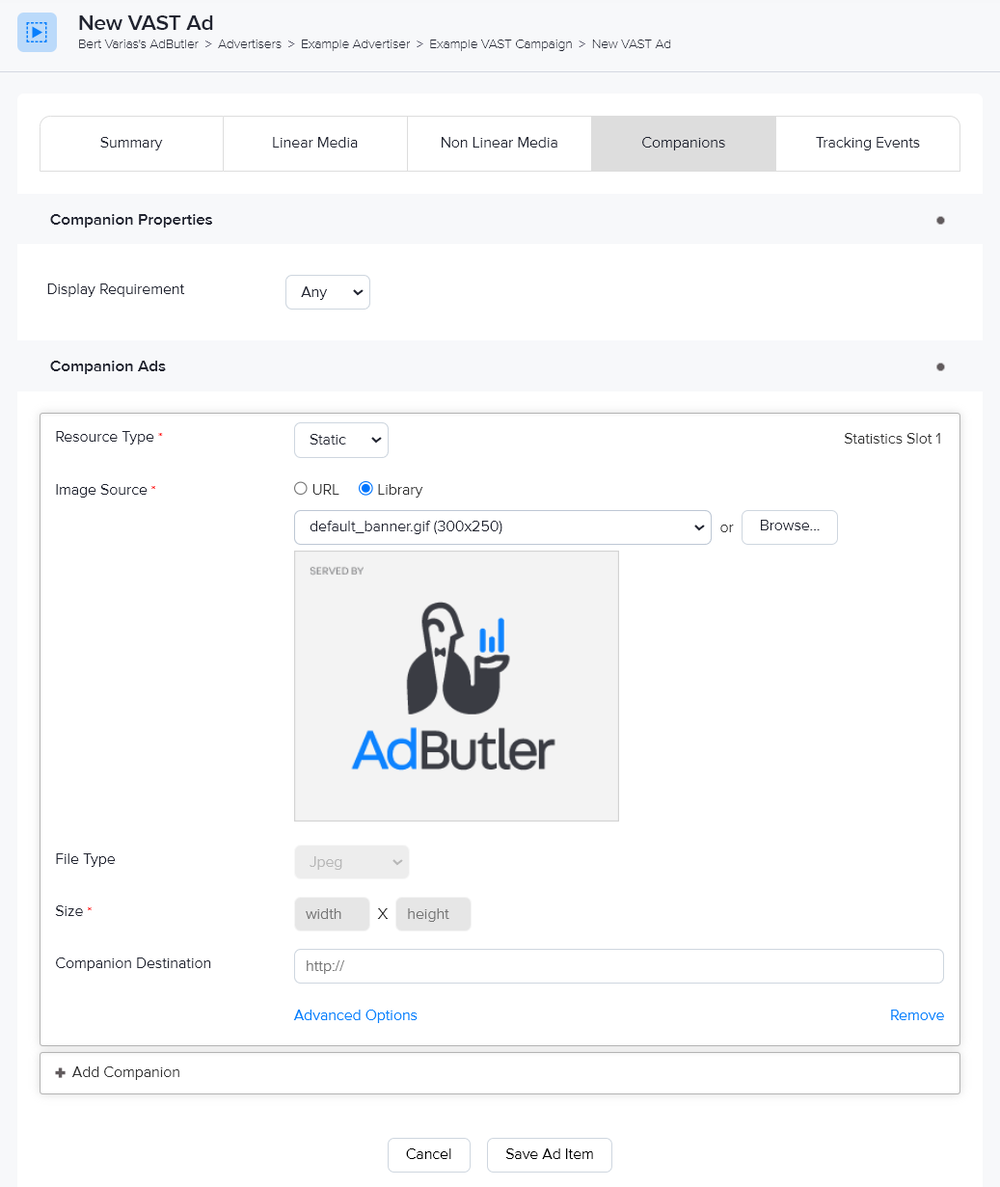
You can add up to five companion ads to a linear ad. For tracking events, the ads will be identified as Companion 1, Companion 2, and so on up to Companion 5, based on the order that they were created.
- Click on the Companions tab.
- Select the display requirement for the companion ad.
- Any - the video player must atttempt to display at least one of the companion ads alongside the linear ad.
- All - the video player must attempt to display all of the companion ads alongside the linear ad.
- None - let the video player decide whether or not to display any companion ad.
Select the resource type of the companion ad's creative.
Select the creative from the Media Library, or upload the file from your computer.
If the image is from an online source, select its file type and enter its dimensions in the appropriate fields.
Click Advanced Options if you need to specify other settings, such as alternative text, ad slot ID, or the ID of any required API.
Click on the Tracking Events tab then select one or more events to track alongside their parameters. You can send the same event to multiple URLs, but you have to make a separate entry for each URL. (optional)
Click Save Ad Item once you've finished configuring all the components of the ad item.
Once you've created at least one VAST ad item in a VAST campaign, you can create a VAST zone then assign the campaign to that zone. For more information on ad items, read About ad items.
Creating a VAST 4.2 ad item
Compared to previous specifications, VAST 4 allows for more diverse and higher quality ads, including high resolution, augmented reality and 360° videos. It also allows for better impression, viewability, and click tracking.
This guide provides only brief descriptions of some of the advantages, features, and options of VAST 4.2. We highly recommend reading the IAB's specification document for more information.
- Go to the section of the relevant VAST campaign (Advertisers > Your Advertiser > Your Campaign).
Click on + Add New v4.2 above the VAST Ad Items table. The New VAST Ad window will appear. From here, you can:
Add a VAST 4.2 wrapper
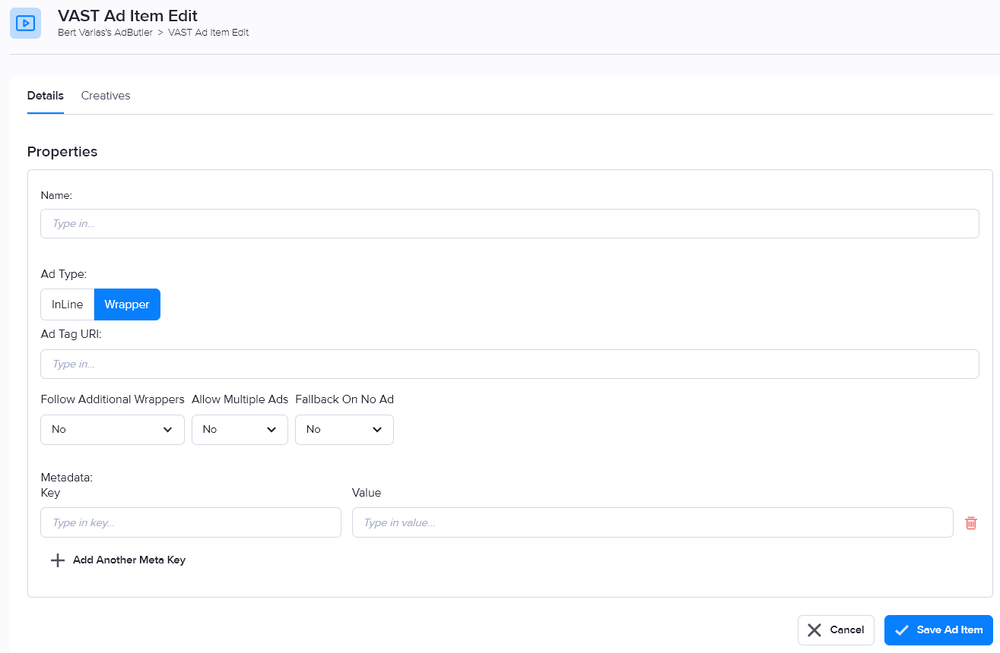
- In the Details tab, give the VAST ad item a name.
- Under Ad Type, click Wrapper.
- Paste the wrapper ad URI from the third-party server in the Ad Tag URI field.
- Select Yes or No from the following options as needed:
- Follow Additional Wrappers - Whether to accept subsequent wrappers in response to a request. When set to Yes, the wrapper will accept another wrapped ad, which itself can link to a wrapped ad, and so on. When set to No, the wrapper will accept actual inline ads only.
- Allow Multiple Ads - Whether to allow both pods (separate ads played in succession) alongside standalone ads in the response.
- Allow Fallback Ad - Whether to allow the media player to select from any standalone ads available when the response returns no ads.
- Add one or more metadata tags to the ad item. (optional)
- Click Save Ad Item.
Add a VAST 4.2 creative
As mentioned in the introduction, a VAST creative can contain one or more VAST ads.
- In the Details tab, give the VAST ad item a name. Leave InLine as the AdType.
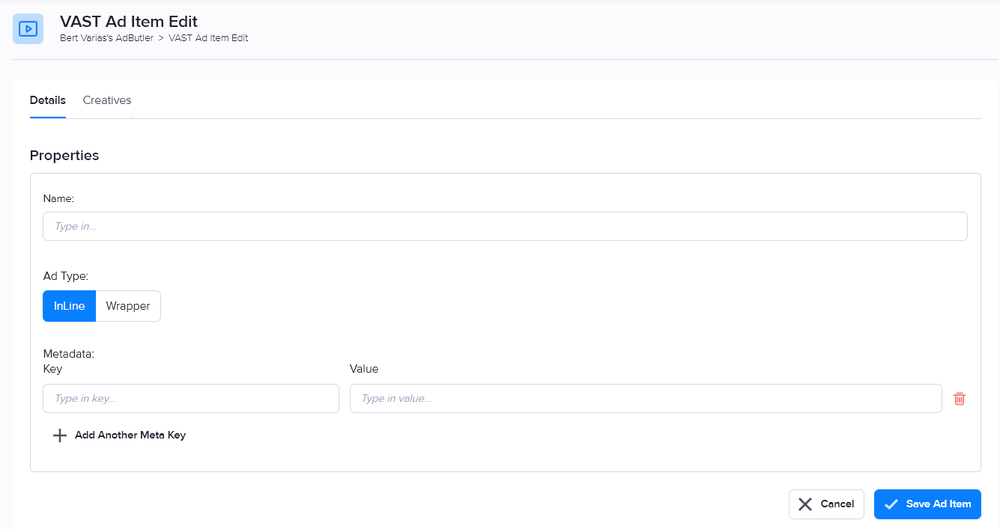
- Add one or more metadata tags to the ad item. (optional)
- Click on the Creatives tab.
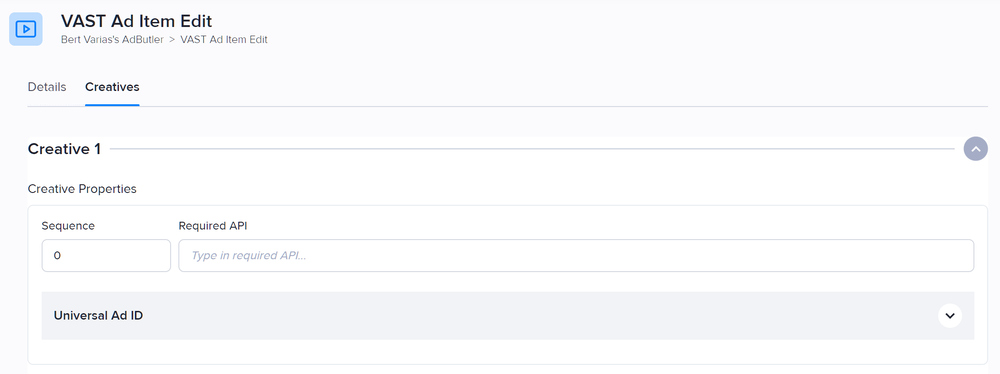
If you are going to add multiple creatives to the VAST ad item, enter the Sequence value for this creative. The first creative you want to appear should have a Sequence value of
1, the second should have a Sequence value of2, and so on. Otherwise, leave Sequence at0.If an API framework is required to execute the linear ad, enter the API string in the Required API field.
Enter one or more Universal Ad IDs for the creative. Ads that will be shown in different countries may require a different Universal Ad ID per country.
From here, you can:
- Add a VAST 4.2 linear ad
- Add one or more VAST 4.2 companion ads
- Add one or more VAST 4.2 non-linear ads
Click + Add Creative at the bottom of the page to add more creatives to the same VAST ad item.
Media files
Before you proceed with creating linear, non-linear, or companion ads, check that your files comply with IAB's guidelines. For more information, read VAST File Recommendations.
Add a linear ad
- Ensure that you are in the Linear Media tab under Creative Medias.
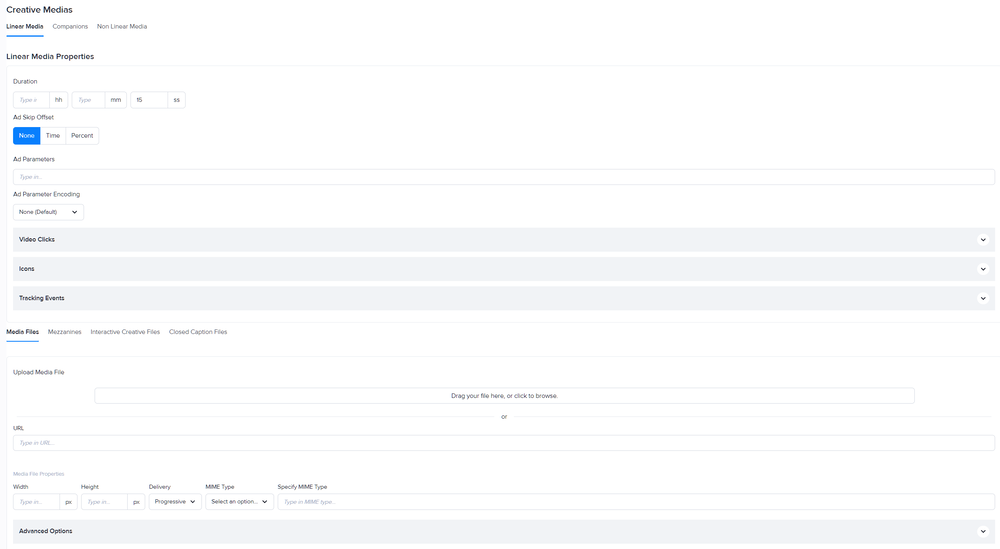
Enter the duration of the linear media file.
Choose an ad skip offset, or the point at which the viewer will be given the option skip the ad.
Enter the ad parameters that will be sent to the media file as well as the encoding for those parameters. (optional)
Under Video Clicks, enter the destination URL and click tracking URL for the linear ad. (optional)
Under Icons, configure the icon or icons that will appear alongside the linear media ad. Note that each icon can have its own click tracking details. (optional)
Under Tracking Events, select one or more events to track alongside their parameters. You can send the same event to multiple URLs, but you have to make a separate entry for each URL. (optional)
Add at least one media file. Click on the appropriate tab to upload or provide the URL to the corresponding file type. When uploading a file, the Media File Properties fields will be automatically populated. When providing only the URL, you must fill in those fields manually. For more information, read VAST File Recommendations.
Click + Add Media File at the bottom of the page to add more media files to the linear ad. (optional)
Click Save Ad Item once you've finished configuring all the components of the ad item.
Add a companion ad
- Ensure that you are in the Companions tab under Creative Medias.
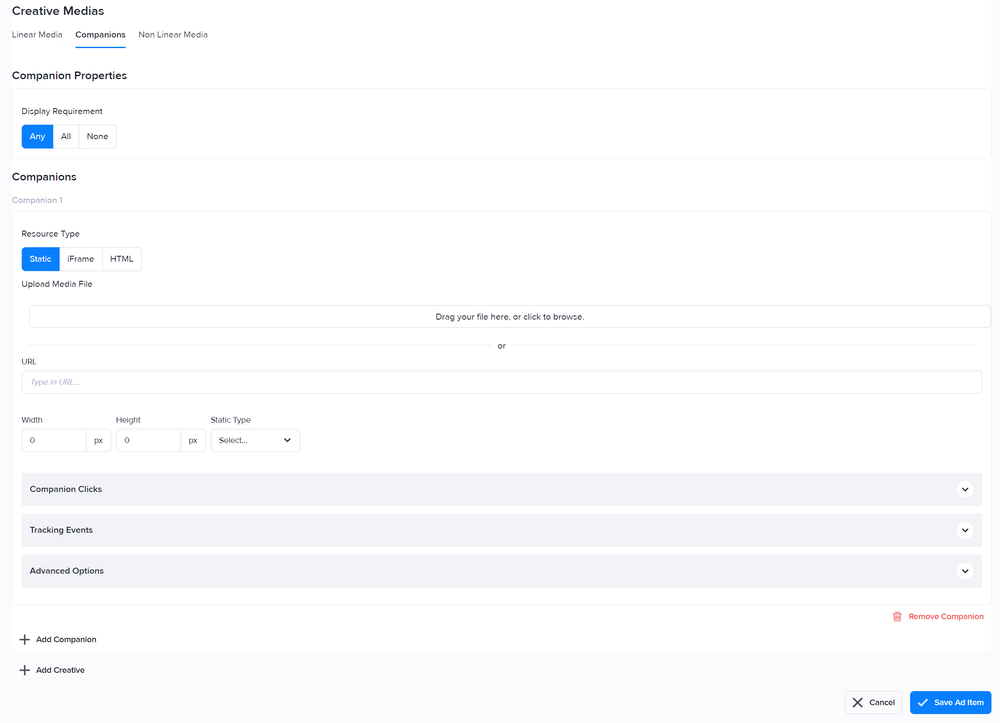
Choose a display requirement:
- Any - the media player must display at least one of the companion ads. Otherwise, the media player will disregard the entire ad item (including the linear or non-linear ad) and return an error message to notify the server.
- All - the media player must display all of the companion ads. Otherwise, the media player will disregard the entire ad item (including the linear or non-linear ad) and return an error message to notify the server.
- None - the media player can opt not to show any of the companion ads. This allows the main linear or non-linear ads to be served even if the companion ad cannot be displayed alongside them.
Choose the ad's resource type and upload or enter the information for the resource. When uploading a file, the file properties fields will be automatically populated. When providing only the URL, you must fill in those fields manually. For more information, read VAST File Recommendations.
Under Companion Clicks, enter the destination URL and click tracking URL for the linear ad. (optional)
Under Tracking Events, select one or more events to track alongside their parameters. You can send the same event to multiple URLs, but you have to make a separate entry for each URL. (optional)
Under Advanced Options, configure your desired serving settings: (optional)
- Ad Slot ID - Specifies a placement on the page. This is an optional value that must be decided between the publisher and advertiser.
- Alternate Text - Text that appears when the viewer hovers over the ad.
- Expanded Width/Height - The maximum dimensions of the companion ad when expanded.
- Pixel Ratio - The pixel ratio of the companion creative. Defaults to
1. - Render Mode - End Card tells the media player to show the companion ad after content playback. Concurrent tells the media player to show the companion during content playback. Default lets the media player decide.
- Required API - The API string for any API framework required to display the ad, if any.
Click + Add Media File at the bottom of the page to add more media files to the companion ad. (optional)
Click Save Ad Item once you've finished configuring all the components of the ad item.
Add a non-linear ad
- Ensure that you are in the Non-Linear Media tab under Creative Medias.
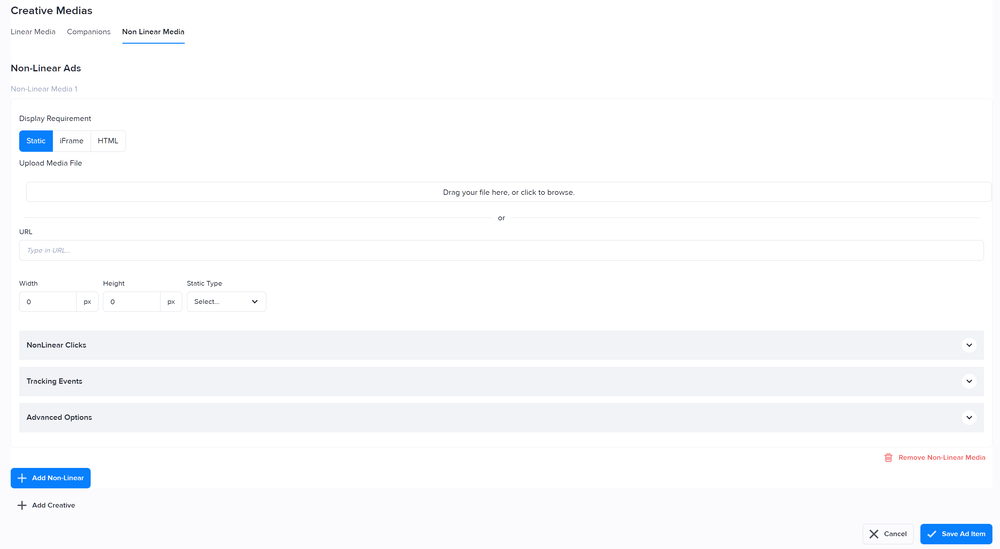
Choose the ad's resource type and upload or enter the information for the resource. When uploading a file, the file properties fields will be automatically populated. When providing only the URL, you must fill in those fields manually. For more information, read VAST File Recommendations.
Under NonLinear Clicks, enter the destination URL and click tracking URL for the linear ad. (optional)
Under Tracking Events, select one or more events to track alongside their parameters. You can send the same event to multiple URLs, but you have to make a separate entry for each URL. (optional)
Under Advanced Options, configure your desired serving settings: (optional)
- Scalability - Whether the ad will also resize when the video player is resized.
- Maintain Aspect Ratio - Whether the ad will maintain its original aspect ratio when the video player is resized.
- Expanded Width/Height - The maximum dimensions of the non-linear ad when expanded.
- Min. Suggested Duration - The desired period during which the non-linear ad will be displayed.
- Ad Parameters - Additional information that will be sent to the media file, if any.
- Ad Parameter Encoding - The format of the ad parameters.
- Required API - The API string for any API framework required to display the ad, if any.
Click Save Ad Item once you've finished configuring all the components of the ad item.
Once you've created at least one VAST ad item in a VAST campaign, you can create a VAST zone then assign the campaign to that zone. For more information on ad items, read About ad items.
Creating a VAST zone
- Go to the section of the relevant publisher (Your AdButler > Publishers > Your Publisher).
- Click Add Zone above the table of zones. The zone type selector will appear.
- Click on VAST Zone.
- Enter a name for the zone.
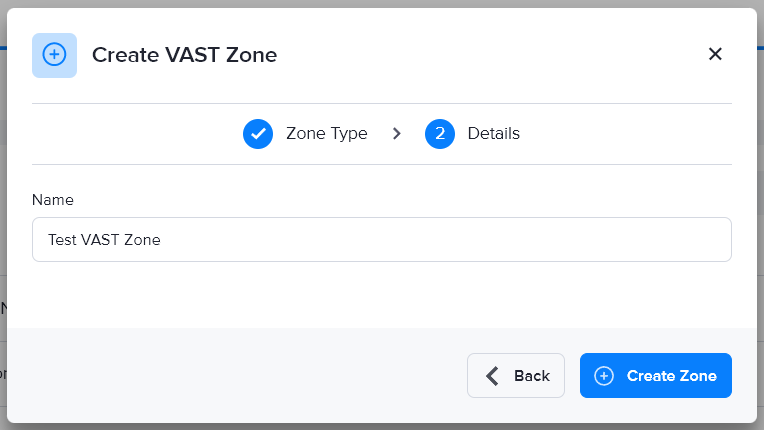
- Click Create Zone. You will be taken back to the publisher's section, and the zone you just created will be listed in the Zones table.
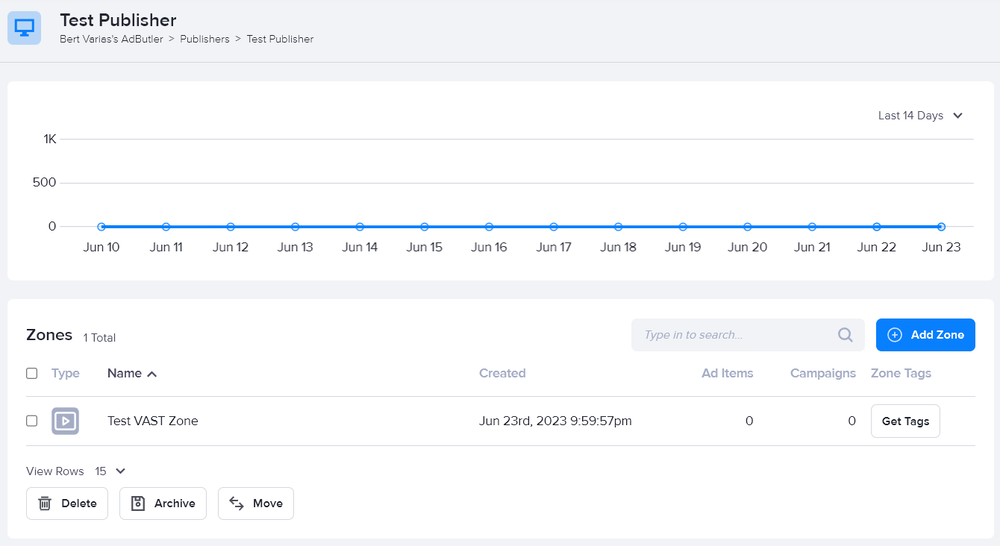
The table shows basic information about the zone: its type, name, the date of creation, the number of ad items and campaigns assigned to the zone, and a button to get the zone's tags.
Once you've created at least one VAST ad item in a VAST campaign, you can assign the campaign to this VAST zone. For more information on zones, read About zones.
Assigning a VAST campaign to a VAST zone
Just as VAST ad items can be created only in VAST campaigns, VAST campaigns can be assigned only to VAST ad zones.
- Go to the section of the relevant campaign ( Your AdButler > Advertisers > Your Advertiser > Your Campaign ).
- Click on Assign to Zone below the Zone Assignments table. A list of eligible VAST zones will appear.

- Click on the checkmark beside your desired VAST zone. The New Placement page will appear.
- Configure the campaign's assignment details. For more information, read Serve method options, Pacing & Schedule, Financial settings, Frequency Capping, and Targeting.
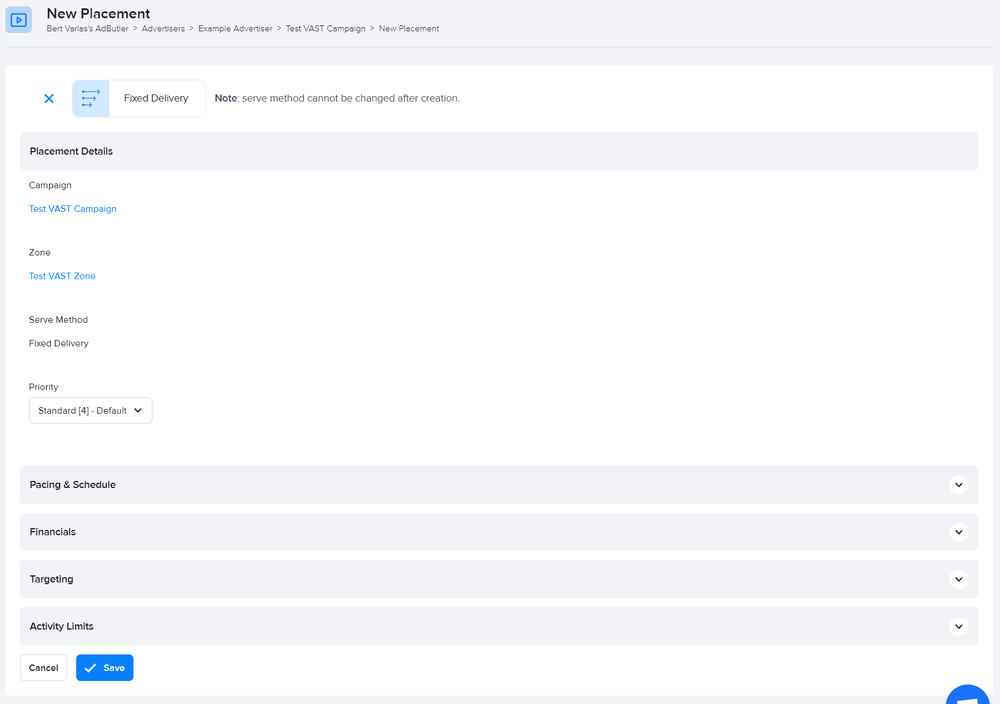
- Click Save.
For more information on assignments or placements, read About assignments.
Testing a VAST zone tag
You may want to test your VAST zone tag before inserting it into your video player. There are free testers available online, including Google's Video Suite Inspector and SpringServe's Ad Tester.
- Go to the section of the publisher that has the VAST zone ( Your AdButler > Publishers > Your Publisher).
- In the table of zones, click on the Get Tags button on the far right column of the VAST zone. The Zone Tags window will appear.
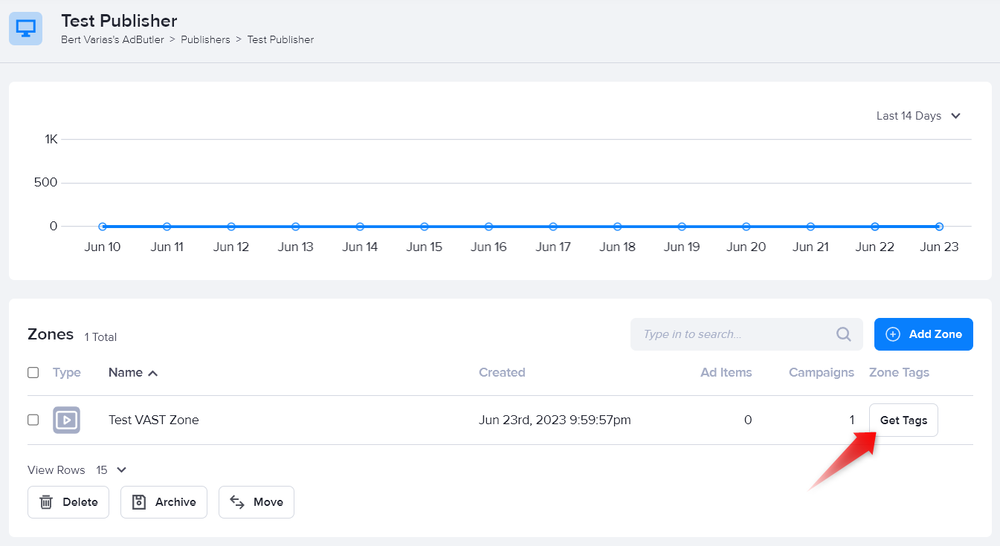
- Make sure that HTTPS (Secure - Recommended) is selected under Protocol. Copy the zone tag.
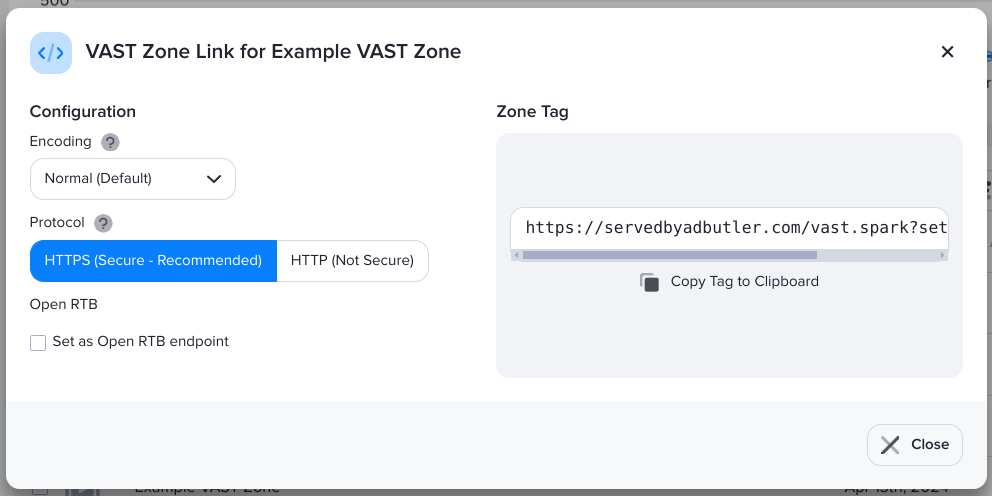
- Go to the online tester. Paste the zone tag into the appropriate field then click on the appropriate button to start the test. The screenshot below shows Google's Video Suite Inspector.
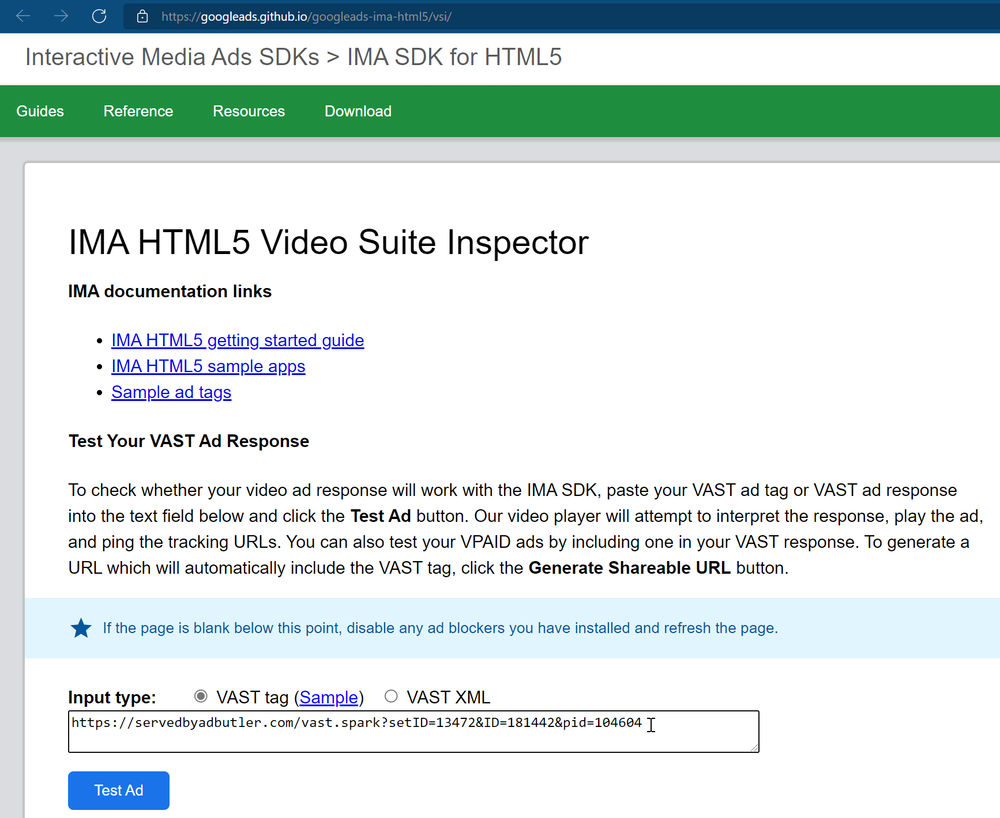
- The tester will attempt to play the ad assigned to the VAST zone, as well as show you an event log. Refer to the log to diagnose any errors in the playback.
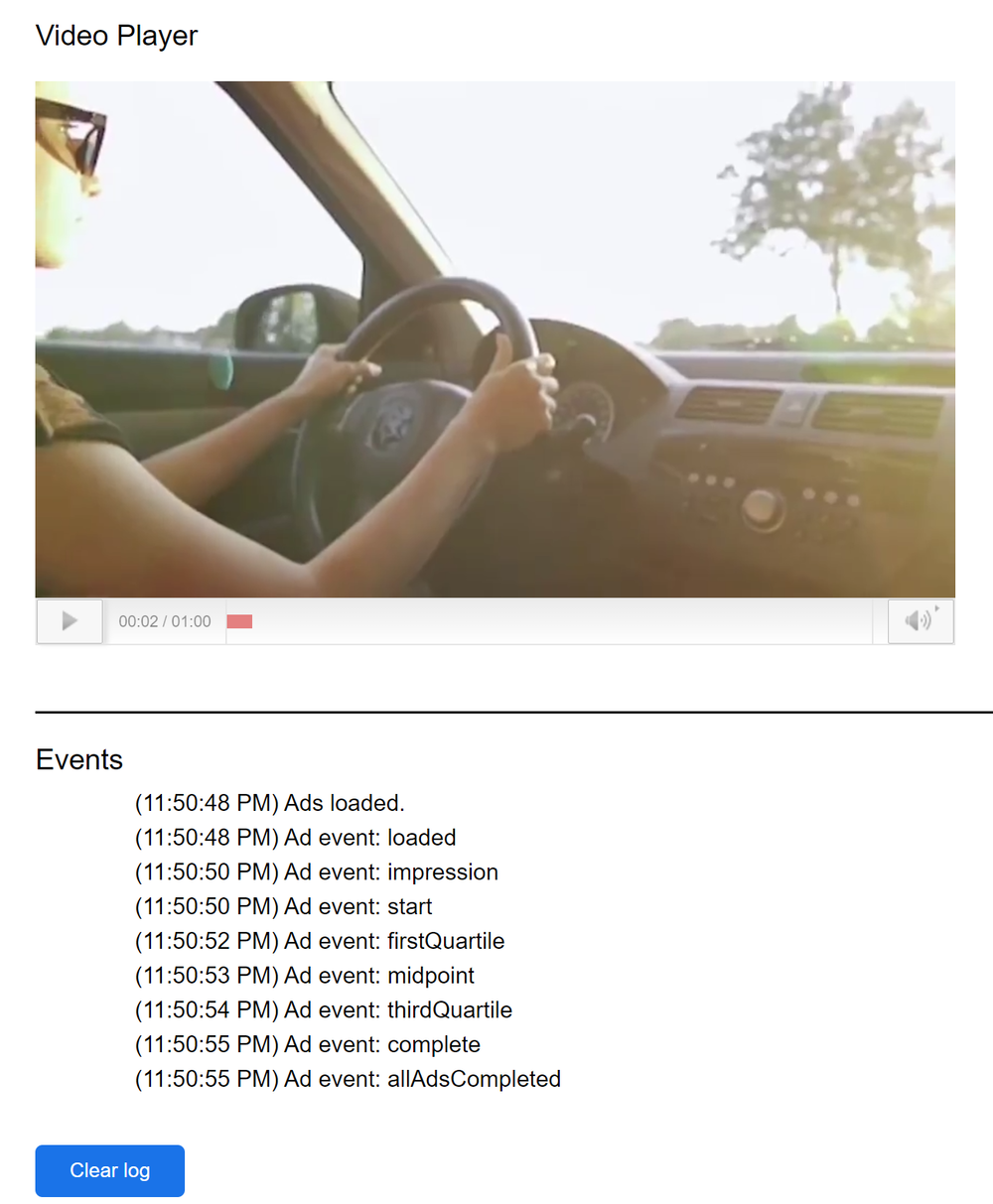
This concludes the guide. The VAST campaign you created should be able to serve VAST ads to the website where the zone tag was placed. Each time the page loads, the tag will make a request to AdButler's servers. An ad from the campaign will then be served to the page.
This demonstrates the basics of serving VAST ads with AdButler, but there are many ways to customize your ad serving setup. We encourage you to read more of our VAST documentation. You can also get in touch with our support team by opening a support ticket while you are logged in to your account.